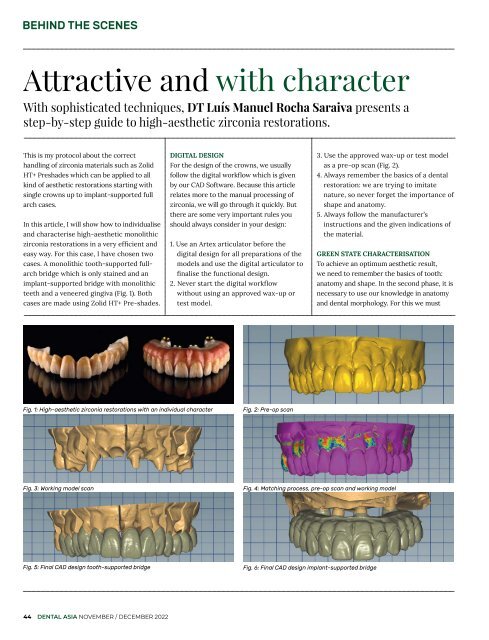Dental Asia November/December 2022
For more than two decades, Dental Asia is the premium journal in linking dental innovators and manufacturers to its rightful audience. We devote ourselves in showcasing the latest dental technology and share evidence-based clinical philosophies to serve as an educational platform to dental professionals. Our combined portfolio of print and digital media also allows us to reach a wider market and secure our position as the leading dental media in the Asia Pacific region while facilitating global interactions among our readers.
For more than two decades, Dental Asia is the premium journal in linking dental innovators and manufacturers to its rightful audience. We devote ourselves in showcasing the latest dental technology and share evidence-based clinical philosophies to serve as an educational platform to dental professionals. Our combined portfolio of print and digital media also allows us to reach a wider market and secure our position as the leading dental media in the Asia Pacific region while facilitating global interactions among our readers.
You also want an ePaper? Increase the reach of your titles
YUMPU automatically turns print PDFs into web optimized ePapers that Google loves.
BEHIND THE SCENES<br />
Attractive and with character<br />
With sophisticated techniques, DT Luís Manuel Rocha Saraiva presents a<br />
step-by-step guide to high-aesthetic zirconia restorations.<br />
This is my protocol about the correct<br />
handling of zirconia materials such as Zolid<br />
HT+ Preshades which can be applied to all<br />
kind of aesthetic restorations starting with<br />
single crowns up to implant-supported full<br />
arch cases.<br />
In this article, I will show how to individualise<br />
and characterise high-aesthetic monolithic<br />
zirconia restorations in a very efficient and<br />
easy way. For this case, I have chosen two<br />
cases. A monolithic tooth-supported fullarch<br />
bridge which is only stained and an<br />
implant-supported bridge with monolithic<br />
teeth and a veneered gingiva (Fig. 1). Both<br />
cases are made using Zolid HT+ Pre-shades.<br />
DIGITAL DESIGN<br />
For the design of the crowns, we usually<br />
follow the digital workflow which is given<br />
by our CAD Software. Because this article<br />
relates more to the manual processing of<br />
zirconia, we will go through it quickly. But<br />
there are some very important rules you<br />
should always consider in your design:<br />
1. Use an Artex articulator before the<br />
digital design for all preparations of the<br />
models and use the digital articulator to<br />
finalise the functional design.<br />
2. Never start the digital workflow<br />
without using an approved wax-up or<br />
test model.<br />
3. Use the approved wax-up or test model<br />
as a pre-op scan (Fig. 2).<br />
4. Always remember the basics of a dental<br />
restoration: we are trying to imitate<br />
nature, so never forget the importance of<br />
shape and anatomy.<br />
5. Always follow the manufacturer’s<br />
instructions and the given indications of<br />
the material.<br />
GREEN STATE CHARACTERISATION<br />
To achieve an optimum aesthetic result,<br />
we need to remember the basics of tooth:<br />
anatomy and shape. In the second phase, it is<br />
necessary to use our knowledge in anatomy<br />
and dental morphology. For this we must<br />
Fig. 1: High-aesthetic zirconia restorations with an individual character<br />
Fig. 2: Pre-op scan<br />
Fig. 3: Working model scan<br />
Fig. 4: Matching process, pre-op scan and working model<br />
Fig. 5: Final CAD design tooth-supported bridge<br />
Fig. 6: Final CAD design implant-supported bridge<br />
44 DENTAL ASIA NOVEMBER / DECEMBER <strong>2022</strong>


















